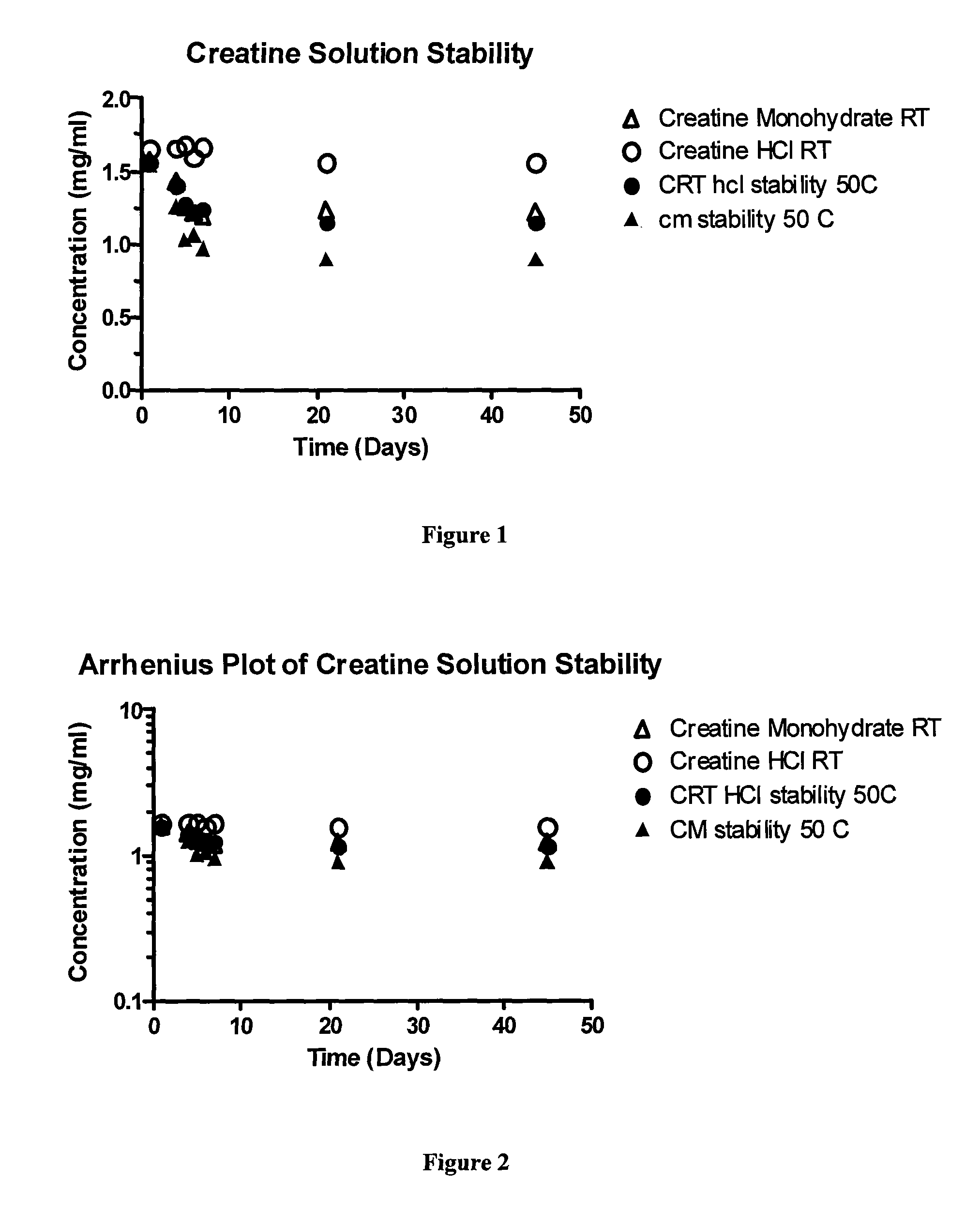Creatine oral supplementation using creatine hydrochloride salt
a creatine monohydrate and supplementation technology, applied in the field of creatine, can solve the problems of affecting the quality of creatine, affecting the effect of creatine monohydrate,
- Summary
- Abstract
- Description
- Claims
- Application Information
AI Technical Summary
Benefits of technology
Problems solved by technology
Method used
Image
Examples
example 1
[0068]Creatine monohydrate and the creatine hydrochloride of the present invention were assessed for relative solubility, and thus bio-availability. The results are shown in Table 1.
[0069]
TABLE 1CreatineCreatineMonohydrateHydrochlorideSolubility (at0.015 g / mL0.888 g / mL62° F.)Relative Solubility 1.059.2(compared tocreatinemonohydrate)
[0070]For the creatine monohydrate sample: 5 grams of creatine monohydrate were added to 100 mL of water at room temperature and stirred for 2 minutes. The solution was filtered, and then dried and massed to determine the amount of sample remaining un-dissolved.
[0071]For the creatine hydrochloride sample: 50 grams of creatine hydrochloride were added to 100 mL of water at room temperature and stirred for 2 minutes. At that time, another 40 grams (4 doses of 10 g each) until the water remained cloudy at the end of the 2 minute stirring period. The solution was filtered, and then dried and massed to determine the amount of sample remaining un-dissolved.
example 2
[0072]The saturated solubilities of creatine HCl and creatine monohydrate were assessed and appear in Table 2.
[0073]
TABLE 2Creatine HydrochlorideCreatine MonohydrateAqueous Solubility679 ± 18 mg / mL17.9 ± 0.5 mg / mLSolution pH0.38.6
[0074]Standard solutions and standard curve determination: 100 mL stock standard solutions of creatine monohydrate and creatine hydrochloride were prepared by dissolving 50 mg of the creatine derivative in 100 mL deionized water. Standard solutions of 10, 20, 30, 40, 50, and 100 μg / mL were then prepared by diluting volumes of stock solution with deionized water. Standard curves for each salt were generated by measuring the absorbance at 210 nm. A linear regression was generated and equation determined for each creatine salt with R2>0.999 in all cases.
[0075]Saturation Solubility Determination: Using preliminary measurements, saturated solutions of creatine monohydrate and creatine hydrochloride in deionized water were determined by adding increasing amounts ...
example 3
[0076]The plasma uptake and relative bioavailability of creatine HCl and creatine monohydrate were assessed. The results appear in Table 3.
[0077]
TABLE 3Creatine HydrochlorideCreatine MonohydrateAverage AUC117.482.2AUC Standard Error10.48.9of the Mean (SEM)
[0078]Bioavailability studies were performed in healthy human volunteers to compare the amount of creatine absorbed following oral administration of a 5 gram dose of either creatine monohydrate or creatine HCl. A two-arm cross-over experimental design was used in which each subject received both creatine monohydrate and creatine HCl. The order of treatment was randomly assigned and there was a 1-week wash out period between creatine treatments. Blood samples were taken immediately prior to creatine monohydrate and creatine HCl ingestion and at various time points thereafter (30-120 minutes). Plasma creatine was significantly elevated following either creatine monohydrate or creatine HCl administration. However, peak creatine plasma...
PUM
| Property | Measurement | Unit |
|---|---|---|
| solubility | aaaaa | aaaaa |
| weight | aaaaa | aaaaa |
| weight | aaaaa | aaaaa |
Abstract
Description
Claims
Application Information
 Login to View More
Login to View More - R&D
- Intellectual Property
- Life Sciences
- Materials
- Tech Scout
- Unparalleled Data Quality
- Higher Quality Content
- 60% Fewer Hallucinations
Browse by: Latest US Patents, China's latest patents, Technical Efficacy Thesaurus, Application Domain, Technology Topic, Popular Technical Reports.
© 2025 PatSnap. All rights reserved.Legal|Privacy policy|Modern Slavery Act Transparency Statement|Sitemap|About US| Contact US: help@patsnap.com


